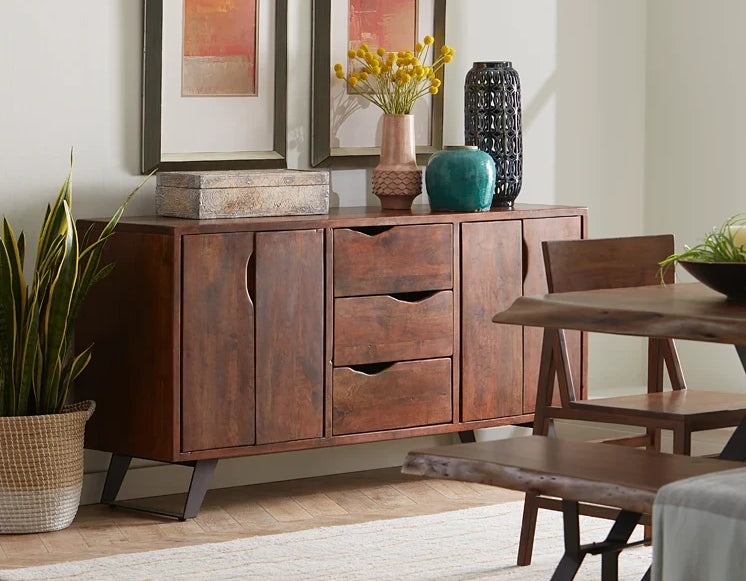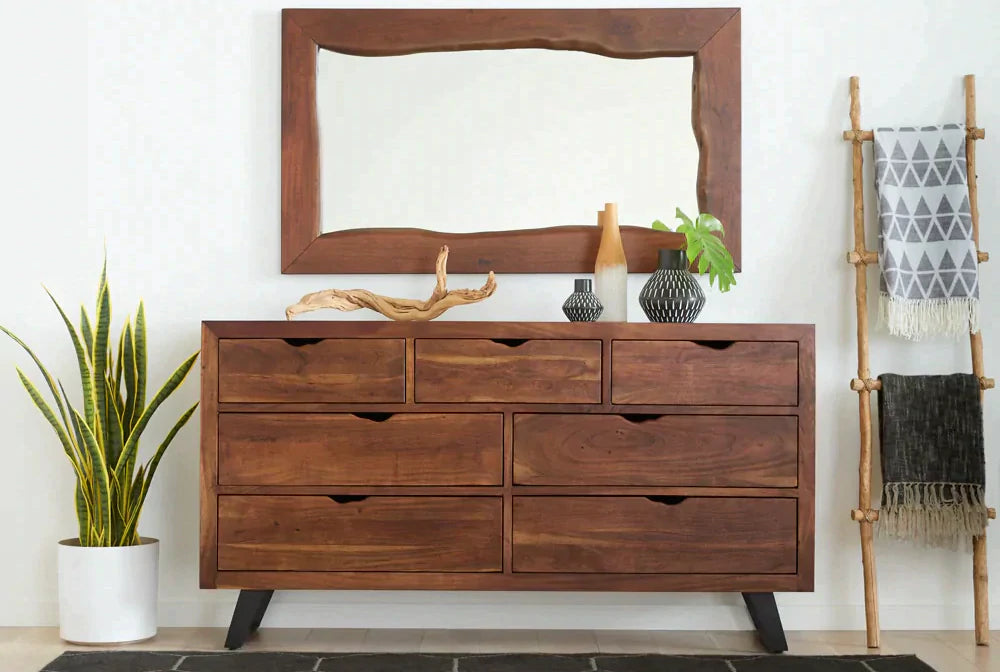Acacia Wood Furniture: Before You Buy
Acacia: A tree of a thousand names
The Acacia tree, also known as Mimosa, Thorntree, and Wattle, a hardwood tree family native to Australia. Over millennia, Acacia spread to now be found throughout the Old World including Africa, Asia, and the Pacific Rim. European settlers brought the tree to the Americas, where a new species began to emerge. There are now 1,350 species of Acacia worldwide!
The species of Acacia we use for our furniture is Babul (Acacia Nilotica). It's native to Africa, India, and the Middle East, and is an invasive species in Australia. We use this species due to its hardness, density, and availability, detailed deeper into this article.

acacia on the world stage
A variety of 18th century writers praised Acacia as a durable and valuable wood, being used for a variety of products such as tree nails, ship posts, beams, cogs, and, of course, furniture! One English writer, Ebeneezer Jessup, enthusiastically proposed the planting of 10,000 acres of the tree in order to provide an enduring source of building materials for the British Royal Navy.
The British Royal Navy, in turn, responded. They valued Acacia for its durability and water-resistant properties, using it as the primary building material for their legendary Ships-of-the-Line. With their advanced Acacia hulls, these ships began to dominate the seas and help place Great Britain as the leading world power of the 18th century.
Acacia wood's uses:
COLLECTION Highlight: Blayne
Elements of farmhouse, rustic, and industrial design combine together to create the Blayne collection. This collection features 2" thick solid acacia wood tops with a natural live edge and raw walnut finish. Finished with a moisture resistant, low-VOC finish and built sustainably-sourced materials. This collection is built to be both eco-friendly and family-friendly.
The stats
Special Note: these characteristics relate specifically to the Babul species of Acacia used to produce World Interiors furniture.
density & hardness of Acacia Wood

characteristics of Acacia Wood
Babul, and Acacia as a whole, has a naturally fine texture (also considered a smooth finish). It's also highly scratch resistant in comparison to other hardwoods.
The grain can vary between straight and wavy patterns, and the color can range from a light amber to a dark mahogany. No two acacia slabs are alike.
Why we choose Babul Acacia for our furniture
We use the Babul Acacia for four main reasons: it's affordable, easy to work with, durable, and sustainable.
affordability
Babul Acacia grows plentifully in Asia, India, the Middle East, and is an invasive species in Australia. It is grown on plantations for its hardened tree sap, known as Gum Arabic. Gum Arabic is used for medicinal purposes, as an additive to soft drinks, and as the outer-coatings for "hard" candies, such as M&Ms.
Usability
Babul Acacia is easy to work with and hardens significantly after it's kiln-dried. This allows us to make benches, buffets, dining tables, and side tables, all without sacrificing the high quality of our furniture. Babul Acacia's workability prior to drying allows us to also craft beautiful live edge pieces, like our Nottingham dining table.
In addition, Babul Acacia's height varies from 2.5 meters (8 feet) up to 25m (82 feet). This makes it perfect for long pieces like our Blayne Rustic Farmhouse Live Edge Bench or our Artezia 72-Inch Live Edge Gathering Table.
COLLECTION highlight: Nottingham
A local favorite, the Nottingham collection combines the natural, organic curvature of the live edge acacia wood with a sleek, hand-forged industrial base to create the perfect balance between natural and industrial elements. The transitional design of this collection functions well in a variety of spaces, from modern suburban homes to large estates.

Durability
As the British Royal Navy has shown, Acacia has proven itself to be an extremely durable wood. Its density and hardness makes it the perfect material for heavy-use pieces such as dining tables and dining benches. When properly maintained, these pieces will last decades.
Sustainability
Though Babul Acacia trees are widely available, we take extra steps to ensure that the wood we use is harvested in a eco-friendly fashion.
We work with local farmers to harvest lumber from these trees after they finish producing the sap used for Gum Arabic. Normally, lumber would either be burned or thrown into a wood chipper for the next planting. By forming working relationships with these farms, they're provided extra income in exchange for giving us a completely sustainable source of wood.
Tips For Maintaining Your Acacia Wood Furniture
We work with local farmers to harvest lumber from these trees after they finish producing the sap used for Gum Arabic. Normally, lumber would either be burned or thrown into a wood chipper for the next planting. By forming working relationships with these farms, they're provided extra income in exchange for giving us a completely sustainable source of wood.
- Wipe the furniture daily with a soft cloth (a slightly moistened cloth is advisable), no need to worry about water spillage due to our water-based lacquer finish.
- Avoid exposing the wood to alcohol, deodorants, perfumes, nail varnishes and similar liquids. If spillage occurs, wipe immediately with a dry cloth. These liquids will pull moisture from wood when left, causing cracking. Alcohol such as red wine would also stain the wood.
- Place your furniture carefully so that it’s not in contact with direct sunlight (this can cause fading and, in extreme cases, cracking).
- Do not place furniture next to fireplaces or radiators as this can cause warping.
- We recommend using placemats and coasters when resting hot drinks or dishes on the furniture.
- Avoid all cleaning tools with a rough surface. This will wear down the finish and increase the likelihood of scratching.
- Avoid polish or cleaning products containing silicone, which can dry out natural wood over time.
- Do not use detergents or any cleaning products that contain ammonia. These will take moisture out of the wood and wear down the finish much faster.
- Due to Acacia's natural scratch resistance, you don't need to worry too much about scratching. If a scratch does appear, use touch-up marker to conceal the scratch. Be sure to test the marker on an unseen part of the table, such as the underside, to ensure that the marker matches the finish.
















